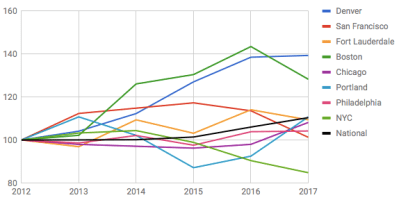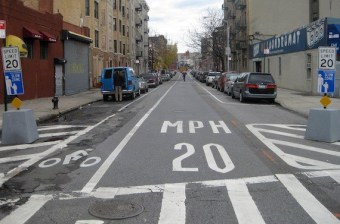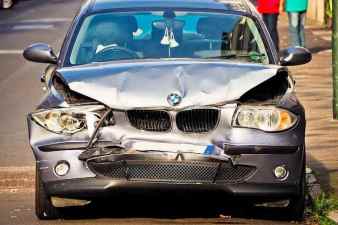A Closer Look at the Drop in Severe Traffic Injuries in NYC
This graph from City Hall’s Vision Zero Year Two Report [PDF], released yesterday, is worth pulling out for a closer look. It shows the number of people who were killed or severely injured in traffic each year. Injuries tracked by this metric “include loss of mobility, traumatic brain injuries and amputations,” according to the report.
Tracking severe injuries and fatalities together provides a better measurement of overall street safety than looking at fatalities or injuries in isolation. It’s less subject to random variation than fatalities alone, which can swing wildly from year to year. By factoring in injury severity, it’s also a better gauge than looking at total injuries, which can obscure how badly people are hurt. (A classic example involves red light cameras, which tend to reduce potentially fatal side-impact crashes while increasing much less severe rear-end crashes.)
Unfortunately, there’s a long lag between the time state agencies receive crash reports from NYPD and when they produce official stats on severe injuries, so we’re just now seeing what happened in 2014. (The Vision Zero report says, “This delay can be avoided through the use of electronic crash reporting, which NYPD is working to implement.”)
As you can see, there’s been a steady decline in fatalities and severe injuries over the past 15 years. You can quibble that City Hall made the first year of the de Blasio administration look better by comparing 2014 to a 14-year average and not starting the Y-axis at zero, but the fact is that 2014 saw the largest percentage drop in severe traffic injuries, compared to the previous year, since at least the turn of the century — about 13 percent.
We don’t have enough information to say why street safety improved that much in 2014. There are many factors that influence injury rates. And maybe that year was a little fluky. Still, one thing that stands out about 2014 is that it was the first full year that NYC operated speed enforcement cameras.
The city’s initial allotment of 20 cameras, secured during the Bloomberg administration, were turned on in September 2013. Since NYPD so rarely tickets speeders except on highways, the arrival of the cameras was tantamount to the arrival of speeding enforcement on surface streets.
In the fall of 2014, the 25 mph citywide speed limit that the de Blasio administration advocated for took effect, and the city began rolling out a complement of 120 additional speed cameras (they wrapped up in 2015).
The cameras are still limited, however, by the absurd restrictions that Albany placed on their location and operating hours — only streets near schools can have them, and they can only enforce the speed limit during school activities. An expanded speed camera program should be an urgent priority, which City Hall says will be on its Albany agenda this year.




